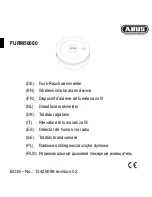
Page 12
In the event of a smoke alarm activation, do not use the Silence feature until the
source of the alarm has been identified and safe conditions exist.
The Silence feature is intended to temporarily silence the horn while identifying and correct-
ing the problem. To use the Silence feature, press and release the test/silence button until the
horn is silent if it was the initiating alarm. If the test/silence button is pressed while the alarm
is in the silence mode, the alarm will start sounding again.
The CO alarm Silence feature
can be activated by a press and release of the test/silence
button on the initiating alarm while in alarm condition. The alarm will remain silent for ap-
proximately 5 minutes, depending on the level of CO detected. The red CO LED will blink
on approximately every 10 seconds. If CO levels drop below the alarm levels, the alarm will
remain silent and return to normal operation. If CO levels remain constant or increase, the
alarm will sound again. This indicates a potentially dangerous situation. Ventilate the area.
The smoke alarm Silence feature
can be activated by press and release of the test/silence
button on the initiating alarm while in alarm condition. The alarm will remain silent for approx-
imately 8-12 minutes, depending on the level of smoke detected. The red smoke LED will
blink on approximately every 10 seconds. If smoke levels have not cleared during the silence
period, the alarm will sound again. This indicates a potentially dangerous situation. Ventilate
the area. If the alarm remains silent, the smoke levels have dropped and the alarm will return
to normal operation. If smoke levels remain constant or increase, the alarm will sound again.
TESTING INSTRUCTIONS
NEVER use an open flame of any kind to test this alarm.
You may
accidentally damage or set fire to the alarm or to your home.
NEVER use vehicle exhaust to test the alarm!
Exhaust may cause permanent damage
and voids the warranty.
NEVER use a gas range or an open flame of any kind to test this alarm.
You might
accidentally damage or set fire to the alarm or to your home.
CAUTION:
Continuous exposure to the high sound level of this alarm over an extended
period of time may cause hearing loss. Due to the loudness, we suggest that you place your
fingers over the sounder opening, or step back from the alarm while testing.
NOTE:
The alarm horn loudness meets or exceeds current UL standards of 85 dB at 10 feet
(3 meters).
WEEKLY TESTING:
This alarm is designed to act as a monitor, not for use as a short-term
testing device, or to perform a quick check for the presence of CO or smoke. The built-in test
switch accurately tests the alarm operation as required by ANSI/UL 2034/UL 217 Standards
for Safety. If at any time the alarm does not perform as described when tested, replace it
immediately. Weekly testing is required to ensure proper operation. Irregular or low volume
sound may indicate a defective alarm and it should be returned for service. Follow deactiva-
tion instructions to prepare alarm for shipment or disposal.
USING THE TEST FEATURE:
Press and release the Test button on the alarm cover. During
testing, the alarm will sound a loud horn pattern consisting of 3 beeps, followed by a 6
second pause, then 4 beeps. The green LED will be on and the red smoke LED will blink in
sync with the 3 beeps and the red CO LED will blink in sync with the 4 beeps. The alarm will
sound if all the electronic circuitry, horn and battery are working properly.
In an interconnected installation, all interconnected alarms should sound when the test button
is pressed on any one of the alarms.
If the alarm does not sound properly:
1. Disconnect the power and recheck your wiring and connections. Restore power and re-test.
2. Check the fuse or circuit breaker supplying power to the alarm circuit.
3. Hold the test button down longer. Try holding the test button down for up to 10 seconds.
4. Make sure the battery activation pull tab has been completely removed.
5. If there is still a problem, call customer service. Do not attempt to fix the alarm.
ALARM AND BATTERY DEACTIVATION
This alarm uses a sealed battery for temporary backup power.
The battery should last for approximately 10 years under normal operating conditions.




































